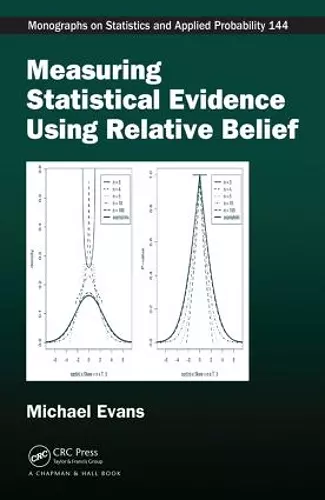Measuring Statistical Evidence Using Relative Belief
Format:Hardback
Publisher:Taylor & Francis Inc
Published:23rd Jun '15
Currently unavailable, and unfortunately no date known when it will be back
This hardback is available in another edition too:
- Paperback£47.99(9781032098562)

A Sound Basis for the Theory of Statistical Inference
Measuring Statistical Evidence Using Relative Belief provides an overview of recent work on developing a theory of statistical inference based on measuring statistical evidence. It shows that being explicit about how to measure statistical evidence allows you to answer the basic question of when a statistical analysis is correct.
The book attempts to establish a gold standard for how a statistical analysis should proceed. It first introduces basic features of the overall approach, such as the roles of subjectivity, objectivity, infinity, and utility in statistical analyses. It next discusses the meaning of probability and the various positions taken on probability. The author then focuses on the definition of statistical evidence and how it should be measured. He presents a method for measuring statistical evidence and develops a theory of inference based on this method. He also discusses how statisticians should choose the ingredients for a statistical problem and how these choices are to be checked for their relevance in an application.
"This creative book by Michael Evans describes not only a new way to measure the strength of evidence but also a system of statistical data analysis on the basis of that measure. That system, specifically designed in response to problems with conventional frequentist and Bayesian statistics, has advantages over previous solutions to those problems. The core of the system is its concept of the degree of relative belief in a hypothesis.
The author defines relative belief in a hypothesis of positive prior probability as the ratio of the posterior probability that the hypothesis is true to the prior probability that it is true. The relative belief in a simple null hypothesis of 0 prior probability is then defined as the relative belief in a hypothesis of positive prior probability in the limit as it shrinks toward the simple hypothesis…. In short, Evans makes concrete recommendations for evidential data analysis based on informed reflection on Lindley's paradox, the logical coherence principle, and the conditional probability principle."
—David R. Bickel, in Mathematical Reviews Clippings, December 2017
"This book presents a comprehensive survey of the literature on measuring statistical evidence based on relative beliefs…This book integrates recent developments into a coursebook format with a pedagogical introduction to the area. The author is a main contributor in the field and the book systematically assembles material conveying his findings and his views on statistics as a whole…The first three chapters provide the readers with a basic introduction to the foundations of probability and statistics viewed through the lens of the author’s school of thought…The second part of the book is devoted to the measurement of statistical evidence based on relative beliefs…Though the first (overview) part of the book does not presuppose much background knowledge, my feeling is that a sound grasp of the subject will help the reader come away with a solid understanding and interpretation of this tour. On the other hand, the main theoretical part does not require many technical prerequisites and is accessible to students having a basic background."
—Markus Bibinger, University of Marburg, in Journal of the American Statistical Association, Volume 111, 2016
"… a fascinating book, in that it defines a coherent and original approach to the vexing question of assessing and measuring evidence in a statistical problem. And spells out most vividly the issue of prior checking. … the book is a great opportunity to discuss this approach and to oppose it to potential alternatives, hopefully generating incoming papers and talks."
—Christian Robert on his blog Xi'an’s Og, July 2015
"The book is a pleasure to read and presents a really unique view of statistics as a whole and how to measure evidence in particular. … this is one of the most important books written recently on the foundations of statistics, providing a modern and logical perspective on the reasons for good Bayesian statistical practice."
—David Nott, National University of Singapore
ISBN: 9781482242799
Dimensions: unknown
Weight: 498g
250 pages